SA Weekend: Crack team of South Australian experts on a mission to save an iconic threatened species by breeding ‘Super Koala’
A crack team of South Australian experts has embarked on a radical plan to breed a koala capable of ensuring the future of the threatened species.
Lifestyle
Don't miss out on the headlines from Lifestyle. Followed categories will be added to My News.
A crack team of South Australian experts has embarked on a radical plan to create a new breed of koala to protect the future of the threatened species.
Playfully referred to as a “Super Koala”, the new breed would be free of debilitating disease, such as chlamydia and retrovirus.
“We’re actually talking about the future of a species here,” says Professor Chris Daniels, leading South Australian scientist and conservationist.

APOLLO’S CREED
It’s a peach of a day at Cleland Wildlife Park, a conservation reserve on the lip of Mount Lofty Summit, about half an hour’s drive from Adelaide’s CBD. The temperature sits in the mid-20s. The sky is cloudless.
Apollo sits quietly on a branch in the park’s koala enclosure, his eyes struggling to stay open as he basks in the beaming sun.
It’s hard not to be taken by these creatures. The dessert spoon noses. The fluffy, moon-shaped ears. The dismissive grumpiness whenever you try to engage.
It’s an image that’s just so quintessentially Australian and one with which we’ve all become so familiar, from the cartoon reels of Blinky Bill, to the heartbreaking images from the Kangaroo Island fires.
And while Apollo is clearly oblivious to the fact as he drifts off to sleep, he could play a key role in the survival of his species.

THE CHALLENGE
The science behind it is as complicated as it comes, but the story itself is relatively simple.
Koalas are in trouble. Deep, deep trouble.
On the east coast they’re dying at alarming rates thanks to a combination of land clearing, climate change and diseases such as chlamydia and retrovirus.
The crisis reached a crescendo on the eastern seaboard in February when they were declared an endangered species in NSW, Queensland and the ACT, making international headlines.
In South Australia, the healthiest population was devastated by the 2020-21 Kangaroo Island bushfires. Those remaining are largely inbred and, therefore, susceptible to disease, which threatens their long-term survival.
“We’re actually talking about the future of a species here,” says Professor Chris Daniels, one of SA’s best known scientists and conservationists.
“We are asking how we can save the species, not here, not in Bundaberg, or wherever – but the species. Full stop. It’s as serious as that.”
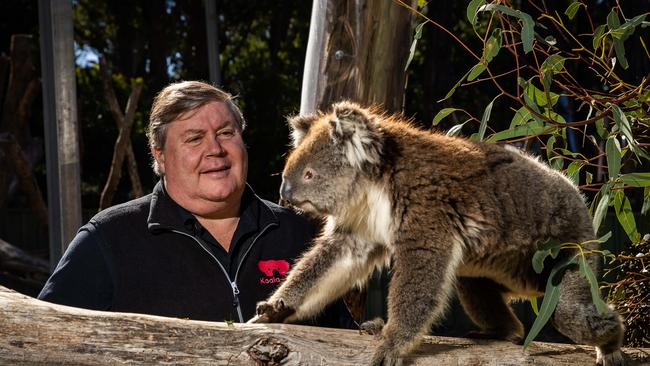
Now Daniels and a world-renowned team of scientists, researchers, conservationists and koala lovers, backed by a large collection of philanthropists and under the banner of the Koala Life foundation, have embarked on an ambitious plan to do just that.
It’s not without its problems or its sceptics, but the desire and determination is strong.
And the confidence is high.
The whole program kicked off when 28 healthy koalas were taken from KI in the wake of the fires and housed at Cleland. They became known as “The Golden Children”.
Then four sub-adult male koalas – disease free as chlamydia and retrovirus are largely sexually transmitted – were rushed across the SA-Victorian border from the Strzelecki Ranges in December last year to breed at Cleland.
Enter “The Strzelecki Boys”.
The general idea is that if you put “The Golden Children” and “The Strzelecki Boys” together, you create a new disease-free koala at Cleland, which at this point has the only disease-free colony in Australia.
The breed would be the first of its kind anywhere in the world.
Let’s call it a Super Koala.
“I like the ring of that,” Daniels says, smiling.

THE COLLECTION MISSION
It wasn’t quite a stealth raid in the vein of Zero Dark Thirty, but it was a complex mission, with a high potential for failure, which required cool heads, military precision and meticulous planning.
It was the culmination of 15 months work involving former environment and water minister David Speirs and his Victorian counterpart Lily D’Ambrosio and their departments. And the rules were strict.
Only 16 koalas could be brought down from the trees, from which only a maximum of six males could be kept. They had to be taken from plantations. They had to be identified beforehand. Capture attempts could take no longer than 10 minutes. Once captured, they had to be at Cleland no longer than 24 hours later to minimise transport stress. They had to be disease free. The temperature could not exceed 30C either in Victoria or Adelaide.

The list went on. And on. Once all the boxes were ticked, an expert crew of 30 from the Department for Environment and Water, Hickman Victoria Plantations and Koala Life, complete with portable laboratory, drones and thermal imaging equipment, converged on Churchill, Victoria, in mid-December last year.
Drones combed the tree lines of the Strzelecki Ranges in the early hours of the morning in search of koalas. Thermal imaging located them. GPS marked the trees. Then the climbers arrived after sun-up.
Resembling human spiders, with elaborate leg spikes and ropes, they ascended the slender gum trees, sometimes as high as 20m, to find the marsupials. Once found, the drones were sent up, again, this time to determine the sex.
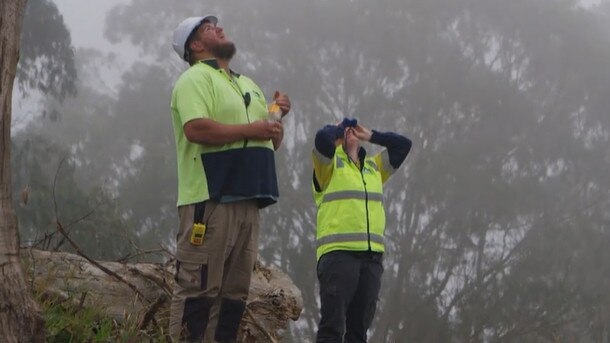
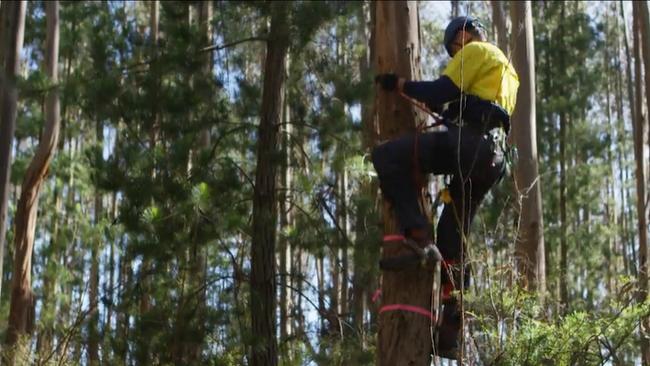
This is where things got a little tricky.
“We couldn’t bring down too many. We worried that the drones might disturb the koalas and they’d jump out of the trees in fright,” Daniels says.
So in the lead-up, Koala Life and researchers from Flinders University, headed by Dr Diane Colombelli-Negrel, studied koala stress levels when drones were being used, with specially designed Fitbits monitoring their responses and heart rates.
The result? The koalas weren’t too fussed.
“So that actually told us there was no stress caused by drones, and that is logical because koalas live with noisy, angry birds like eagles, kookaburras, magpies and so on. So the stress of being buzzed by a drone was actually very low,” Daniels says.
To complete the exercise, the climbers waved a rag connected to a pole over the koalas’ noses and, invariably, they would calmly back down the tree into the waiting arms of Dr Ian Hough, Australia’s pre-eminent koala veterinarian.
“Well, they were calm most of the time,” Hough says with a wry grin. “They’re a tricky animal.”
The mission worked.

Across three full days, drones found 73 koalas. Just seven were brought to ground, all safely. Four young, healthy males were suitable and rushed to Mount Gambier.
“Except that, of course, you couldn’t travel from Victoria to South Australia,” Hough says of the Covid border closures.
“Now what we had to do is find someone in Victoria who could go into the bubble, and then someone who lived and worked in the bubble to take them across the border to Mount Gambier and then somebody from here (Cleland) to drive to Mount Gambier to pick them up.
“So you know, very, very John Le Carre-type stuff.”
Helped by SA Police at the Mt Gambier checkpoint, the koalas were placed in the care of Koala Life vet teams and taken to Adelaide Zoo and Cleland to begin nine weeks of adjustment.
With one small hitch.
To help them adapt to their new surroundings, they were given aptly named “poo smoothies”.
“One of the big problems with translocating koalas is that bacteria in the gut is very, very selective for the plants that they were eating at the site,” Daniels says.
“So if you’re transporting them to SA, you can’t transport leaves across the border, so you have to collect the poos of koalas here that are eating the gum that will be fed to new arrivals.
“You take the poo out, you grind it up, into the slushie.”
“Enjoy.”
The Strzelecki Boys had arrived.
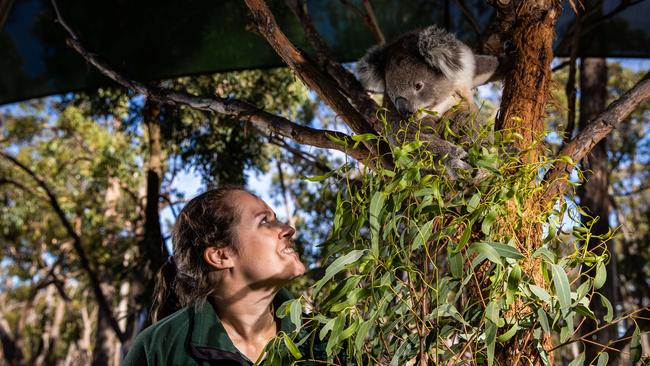
SURVIVAL SCIENCE
Daniels’ eyes light up when discussing koalas. We meet in a quiet corner of a hotel in Adelaide’s foothills a few hours before a board meeting with the director of Green Adelaide, where he is also presiding member.
As the current chair and founder of Koala Life, he’s passionate when discussing the future of the marsupial and even more animated when waxing lyrical about “survival science”.
“Survival science is more than just habitat conservation,” he says.
“Really since Teddy Roosevelt, we practised the concept of going back to the start, we practise conservation science by protecting habitat.
“You know Kakadu, a Great Barrier Reef, you find it, you keep it, put a fence around it.
“It does a great job and is still the mainstay of how we preserve species and ecosystems.
“But it’s not enough.”
Species and ecosystems are still declining quickly, caused by a variety of factors, not the least of which is climate change, he says.
So you need a variety of approaches to combat it, targeting both species and ecosystems and using a variety of tools: everything from pest and weed control, to revegetation, to citizen science.
That’s a dumbed down version but, in a nutshell, all mixed together, this becomes survival science.
Koalas are a prime example of the need for a broader approach, Daniels says, with much of the funding directed towards new habitats and tree planting.
“Well, the most commonly stated reason is that habitat clearance has removed their ability to survive and also led them to be isolated in a few parks,” he says. “But it’s actually more complicated than that. They also have high levels of disease, particularly in Queensland and NSW.”
So Koala Life chose another route.
“Two years ago, Ian Hough and I recognised the importance of disease-free animals on Kangaroo Island and after the fires we sort of hatched a plan to create The Golden Children and bring in The Strzelecki Boys,” he says.
“They’re important because then we can have koalas that are unlike any koalas in the world, in that they are free of infectious diseases, like chlamydia.”
After “The Golden Children” – a playful reference to the 1986 Eddie Murphy comedy The Golden Child – were transported from KI, a breeding program began to keep the population viable.
To date, about eight joeys have been born.
Now the plan is to get more healthy females mid-year and begin the “Super Koala” breeding program by year’s end.
Daniels says the closest comparison he can think of is the creation of the racehorse.
All modern thoroughbreds can be traced back to three stallions imported into England from the Middle East in the late 17th and early 18th centuries, and a collection of 47 mares known as the Royal Mares.
Those animals were selected because they had specific genetic traits, and careful breeding programs have since established a population of thoroughbred horses that span the world.
Koala Life director Dr Chris West – a vet, former zoological director at the Zoological Society of London, and former chief executive of Zoos South Australia and Edinburgh Zoo – says the program is also significant because it is aiming to, for once, get ahead of the curve.
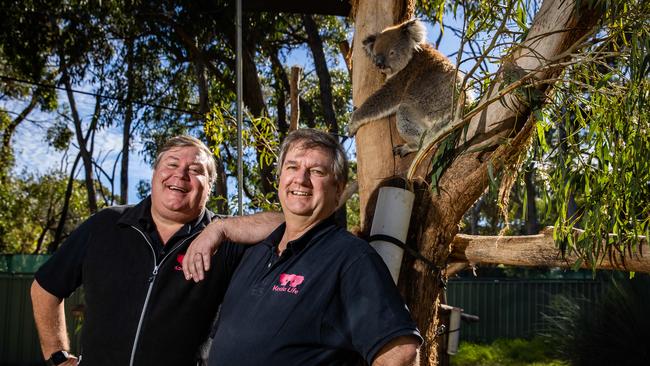
“I think all too often in conservation, we come out really late in the game, when pretty much the game is lost,” West says.
“So the really good thing about this is we’re far enough ahead of it, but we can see where it’s heading. So that we can put things in place and put in an insurance breeding program.
“In a way what we’re doing is building a time bridge, so that we start the founder population and at some point, when the numbers really start to decline, we are prepared. We can see what’s coming over the horizon.”
Which brings us back to “survival science”, the concept of using as many types of recovery programs as possible to preserve a species.
Daniels says: “I’m not knocking the one thing most people are doing. We must retain pristine habitat. But you’ve got to do all this other stuff. It’s never just one thing.”
West adds simply: “Survival science is the future of conservation.”
FIGHT OVER SCIENCE … AND DOLLARS
The fight for koalas is a competitive space. There’s the battle for money. For big names. For attention. Then throw a fair dose of interstate rivalry into the mix.
Daniels says the only way to win over the sceptics to what some have labelled an “audacious” approach, is to simply prove it works. “For us it’s about proof of concept, because it’s still science, which means there’s still a lot about it we think will work, but we still need to prove it,” he says.
The ultimate aim is a disease-free breed of koala – free of the eastern state scourges and, in SA, the curse of inbreeding, namely oxalate nephrosis, a type of kidney disease – and populations which can be co-located around Australia. Failing that?
“The next step is now breeding them, and then showing that it does make a genetic difference and showing that it has an impact on oxalate incidents,” Hough says.
“If it shows both I can retire a very happy man. If it shows one of the two, I still retire, very happy. If it shows neither, it was still the right thing to do.”
Daniels says there is general support in Victoria for the work but a lack of cut-through in other states, which are focused on other means, such as habitat restoration, and are the recipients of much of the federal government’s promised $50m in the wake of the endangered species bombshell.
“They also look down on SA koalas as inbred,” he says, shrugging his shoulders.
There are some outspoken critics to Koala Life’s approach. Specialist koala ecologist Steve Phillips recently told the ABC there are too many unknowns with the program.
“Young male koalas are not tested, they’re full of testosterone, they have little regard for the females they’re potentially going to be mating with,” Phillips said.
“Essentially it will be a forced love feast. The females will have no other option because they won’t be able to escape. For the female koalas it’s not a very pleasant experience at all.
“We also know that the recruitment of genes into koala populations is through the females rather than males, so using males in this program means there’s a high probability the project will fail.”
So what is the science behind the project? And will it actually work?
Professor Corey Bradshaw, from Flinders University, a world renowned expert on genetic modelling, has just embarked on a four-year, $750,000 project funded by the Australian Research Council to try and answer at least some of these questions.
The term he keeps returning to is “genetic rescue”.
“So what we’re trying to do with genetic rescue is the idea of taking what we call an outbred individual,” he says.
“We stick it in an inbred population and its genome, its genetic diversity, is transmitted through the rest of the population.”
Hence breeding the “outbred” Strzelecki Boys with the “inbred” Golden Children.
There are precedents for the work, he says, citing Australia’s mountain pygmy-possum populations. However, he agrees it is complicated, and there are many unknowns.
“There’s other examples around the planet but it’s kind of wing it and see,” he says.
“First of all, we don’t really know what degree of outbreeding is required.
“You don’t know the frequency with which you have to introduce outbred individuals.
“We don’t know the spatial distribution of those introductions, you know, do you have to put them in all parts of the population, or is one site good enough?
“We won’t know any of these answers until we peer inside their pouches in about a year.”
So while it’s a four-year project, it will likely last much, much longer.
The potential pay-off, however, is enormous. If successful it would be “sold to the top scientists in the world (as a) model for genetic rescue across marsupials”.
And, obviously, have an immediate impact on the crisis facing koalas.
“They’re crashing on the east coast, mainly from deforestation,” Bradshaw says.
“So this is also potentially an insurance population for the entire country.”
Daniels says if this occurs “it won’t matter what state came up with it”. “A few naysayers said we wouldn’t get this far and we’ve proven them wrong … so far,” he says.
Ian Hough agrees, and says he wishes more people would simply pull up their sleeves.
“I don’t care what the barriers are,” he says.
“We’ll do it. We’ve done it twice now. And that’s got to mean something to all of the other groups working in conservation; actually get off your butt and get out there. You can do stuff. And doing stuff is always better than just talking about what you should have done.”
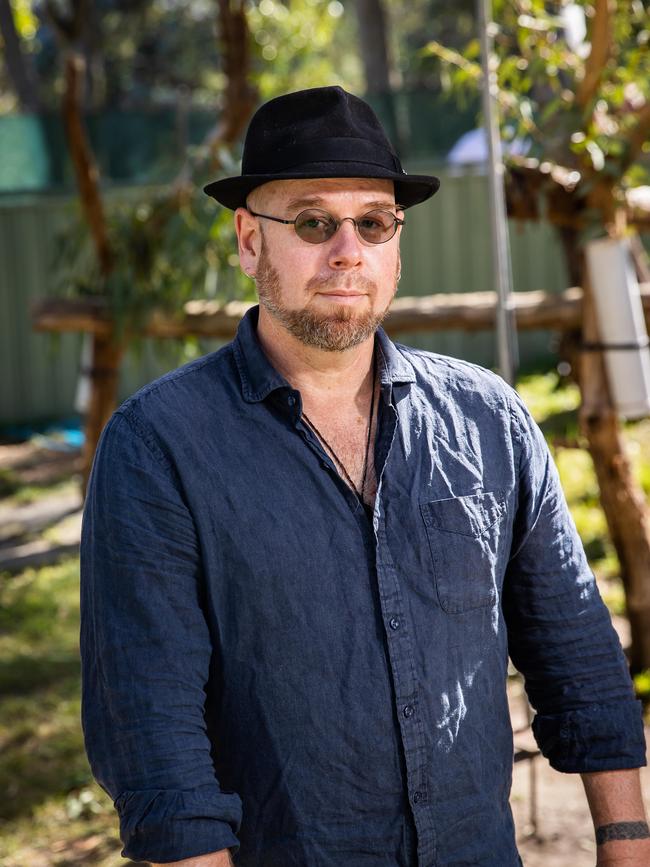

THE CELEBS
Prince Albert II of Monaco, and his foundation, is a big fan. As is Ceawlin Thynn, Marquess of Bath and chairman of Longleat Enterprises.
Both are major donors – much of Koala Life’s funding comes from overseas philanthropy – and Thynn uses some of the Cleland-bred koalas for his private wildlife park, Longleat, in Wiltshire, a county in southwest England, where their local appeal is akin to that of SA’s giant pandas, Wang Wang and Funi.
Koala Life’s ambassadors are high profile and include our own Teresa Palmer, entrepreneur Ian Drummond, adventurer Tim Jarvis, comedian Adam Hills and “the voice of cycling” Phil Liggett, among others in the international environmental elite.
Palmer says she grew up visiting Cleland and, in between overseas acting assignments, often takes her children there. Hers is a lifelong fascination with the marsupial.
“Living on a 10 acre property with many cuddly koala residents has propelled not just my own interest in their preservation but also my children’s too. We make it a family affair,” Palmer says.
“Being a Hills resident, I often see cars stopped in the road with folks ushering koalas safely across the street; I think it’s ingrained in all of us to want to protect and support them.”


Her visits to Cleland led to her meeting Daniels and Hough, and to adopting a more formal position with the group.
“I’m very passionate about koala conservation,” she says, before going on to describe Koala Life’s work as both impressive and inspiring, particularly in the wake of the KI fires. “I noticed such an increase in global attention surrounding koalas and their habitats when the Australian fires were devastating many parts of Australia.
“Witnessing the monumental efforts of Koala Life to support the communities of koalas affected by the fires was truly moving and, without their dedication and the work of other organisations around Australia, the toll those fires took on koala populations could have been irreversible.”
WHAT’S NEXT
The hope is that, within five years, there will be 50 to 60 offspring from the Cleland breeding program, which can then be relocated around SA, then Victoria, then the rest of the country.
To reach this goal, more females will be included in the program, before the breeding program starts in earnest later this year.
“At the moment, we only got about a one to two/three ratio,” Daniels says.
“So we really want to get another 15 or 20 females and then start the breeding.”
Will breeding be a problem for the koalas, as it is for the giant pandas, who have been notoriously slow to mate?
“Ah, no,” West says, and goes on to describe a somewhat volatile courtship.
“They mate multiple times and make a lot of noise while they’re doing it.”
“It’s safe to say the males don’t listen to Barry White,” Daniels adds.
“More like the Sex Pistols.”

Fundraising and grant applications will also be a focus, with more enclosures needed at Cleland. Daniels will only look about five years ahead but says the program could realistically extend for decades.
Who really knows how long it could take to breed out disease to preserve a species and, in the process, create a much stronger one.
“Obviously Cleland is the only place in the world where this is happening for koalas,” Daniels says, almost as an afterthought.


